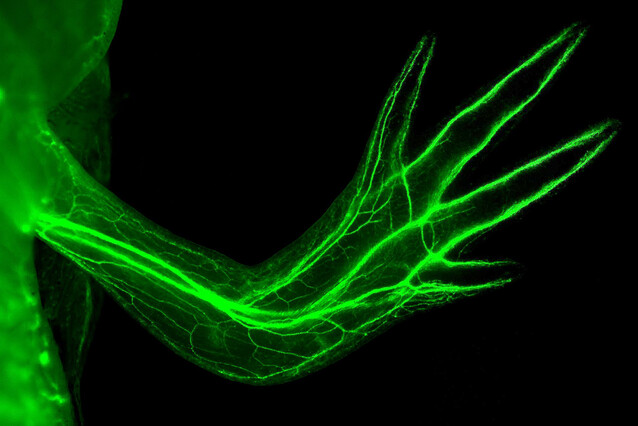ERC Advanced Grant for Elly Tanaka to study innervation of regrowing limbs
Axolotls are famed for their ability to regenerate lost body parts. They can regrow entire limbs with full functionality, which requires the correct interplay of different tissues, for example muscles and nerves. In certain instances, however, regenerated limbs are not correctly “wired” and the reasons for this are yet unclear. A new ERC Advanced Grant for IMP Senior Scientist Elly Tanaka will fund research into this phenomenon.
Limb regeneration involves the reconstruction of multiple tissues, including functioning nerves: certain neurons in the brain or spinal cord project extensions called axons into regrowing limbs to make contact to muscles; other neurons in the limb grow their axons back into the central nervous system to transmit sensations. While innervation is well studied in embryonic development, fairly little is known about how it is achieved in regeneration.
The Mexican salamander species axolotl has the remarkable capacity to regrow lost tissues, organs, and entire limbs, which has made it the model of choice for studying regeneration. One might expect the axolotl to show perfect re-innervation. However, scientists found cases where re-innervation failed completely, or where it was abnormal – and it is unclear how such aberrations impact the animal.
By some measures, axolotls are the oldest model organism in experimental biology, in permanent use since the 19th century. It is largely thanks to the lab of Elly Tanaka that the axolotl is again at the forefront of life science research today: over the course of decades, the lab was key to making axolotls accessible for molecular methods and the prime model for modern regeneration studies. Building on this, the European Research Council (ERC) has now awarded an Advanced Grant for studying the innervation of regenerating limbs to Elly Tanaka and her lab.
With the ERC funding, the scientists will use transgenics, viral tools, and cutting-edge imaging techniques to study the motor and sensory innervation patterns in axolotl limbs, also looking into how these patterns vary from one individual to another. They will then compare successful innervation during normal regeneration and aberrant innervation – for instance when regeneration is aborted.
In these situations, the scientists plan to study the structures and the connections of neurons to determine whether and how nervous tissues adapt.
Video: Parts of the head and body with a forelimb of a transgenic axolotl: green is fluorophore expression in sensory neurons, magenta is fluorescent immunostaining of β-III tubulin, a pan-neuronal marker, labelling all neurons. White marks an overlap of sensory and motor neurons. Video by Lucrezia Galli, Claudio Polisseni, Katharina Lust (IMP).
“Axolotls are the most regenerative vertebrates we know,” says Elly Tanaka. “By studying how axolotl neurons respond to normal and aberrant regeneration, we hope to uncover new types of plasticity or its limits in the axolotl and possibly other systems. I am extremely happy that the ERC has recognised the importance of this work and decided once again to back the work of my lab in the years to come.”
About ERC funding
ERC Advanced Grants provide long-term funding for established, leading principal investigators who want to pursue a ground-breaking, high-risk project. They may be awarded up to 2.5 million Euro for a period of 5 years. This grant is already the third ERC Advanced Grant for Elly Tanaka, and the 24th that the ERC counts as awarded to scientists at the IMP. About two thirds of the IMP’s faculty have received at least one ERC grant.
About Elly Tanaka

Elly Tanaka’s lab studies the molecular pathways that regulate limb and spinal cord regeneration, using the Mexican salamander species axolotl as their main model system alongside mammalian models.
Elly Tanaka studied biochemistry at Harvard University, followed by a PhD from the University of California in San Francisco. She first worked on limb regeneration as a postdoctoral researcher with Jeremy Brockes at University College London. Tanaka started her own lab at the Max Planck Institute of Molecular Cell Biology and Genetics in Dresden in 1999. In 2008, she became professor at the Center for Regenerative Therapies at the Technische Universität Dresden, which she managed as director from 2014 to 2016. Tanaka joined the IMP as a senior scientist in 2016.
In 2017, Elly Tanaka was awarded the Ernst Schering prize “for her outstanding research in the field of regeneration biology”. She is an elected member of the Academia Europaea, the European Molecular Biology Organization (EMBO), and the Austrian Academy of Sciences.
About the IMP at the Vienna BioCenter
The Research Institute of Molecular Pathology (IMP) in Vienna is a basic life science research institute largely sponsored by Boehringer Ingelheim. With over 200 scientists from 40 countries, the IMP is committed to scientific discovery of fundamental molecular and cellular mechanisms underlying complex biological phenomena. The IMP is part of the Vienna BioCenter, one of Europe’s most dynamic life science hubs with 2,650 people from over 80 countries in six research institutions, two universities, and 40 biotech companies. www.imp.ac.at, www.viennabiocenter.org
